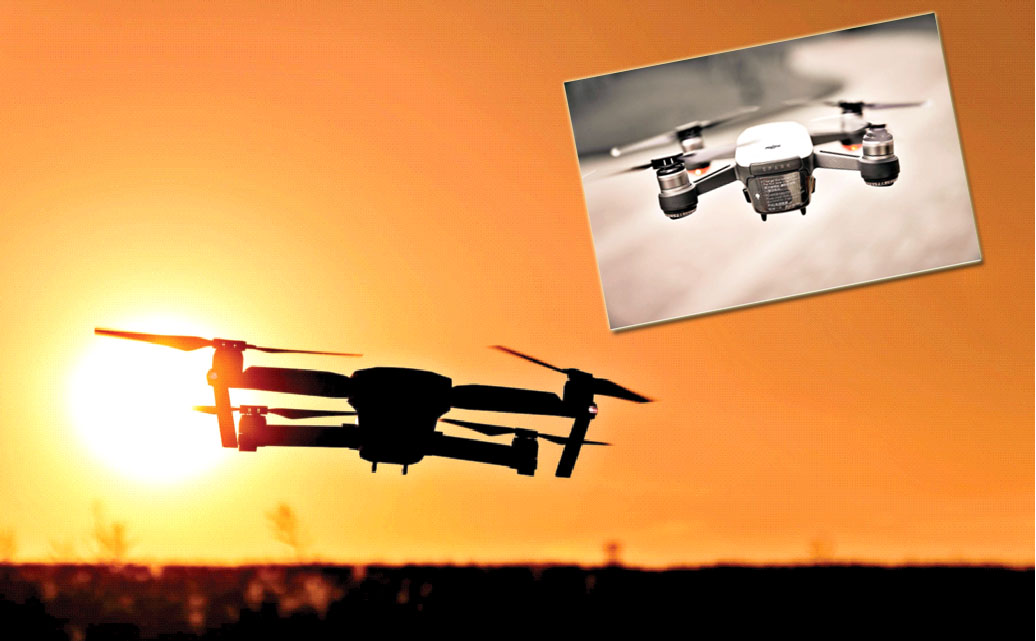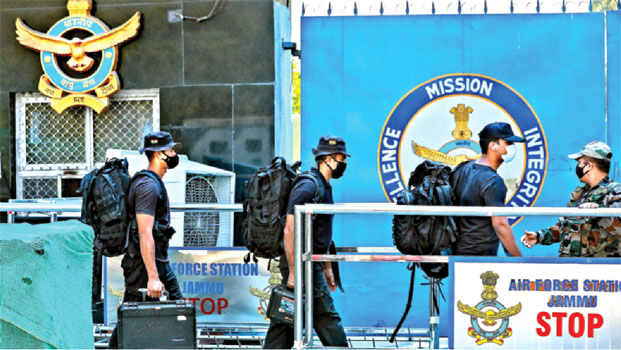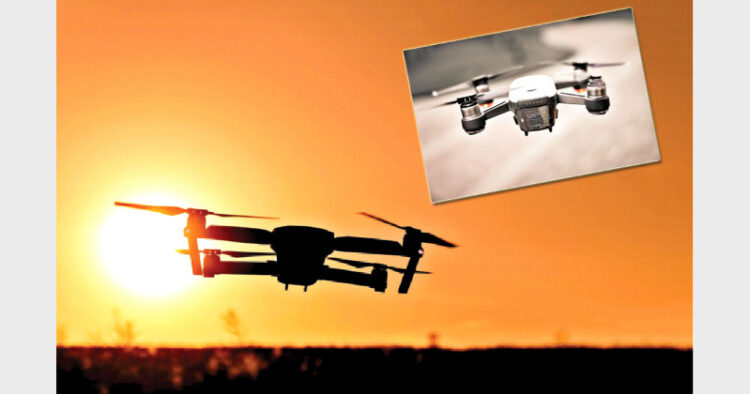Recent drone attack on Jammu Air Force station and emerging threats from space are a wakeup call for the Indian security establishment
-N C Bipindra

The cost of defending against security threats from drones grows exponentially with each attack. This is a fact in the case of space warfare too with every step taken by a nation towards technological progress. These truisms have been demonstrated by recent incidents that are wake up calls for the Indian security establishment.
Take the latest drone attack on the Jammu Air Force station on June 27. The technical area — where the air force operates its flying machines from and has hangers to park them — came under attack suspected to be from two micro-drones.
The Indian Air Force has been conscious of the threats posed by the drones in the hands of both non-state and state actors in its neighbourhood. When we talk of state actors, obviously, am referring to Pakistan and China. The non-state actors, of course, are terror outfits like the Pakistan-based, -funded, -aided and -supported Lashkar-e-Toiba, suspected to have carried out the Jammu air force station drone attack.
Already, Pakistan has been using drones to drop off narcotics and weapons along the International Borders in Punjab and Line of Control in Jammu and Kashmir, and India has shot down some of them in recent years. Indian Air Force Chief Air Chief Marshal Rakesh Kumar Singh Bhadauria told this writer in February 2021 that the force-levels planning for an air force is always based on a realistic assessment of threats in the light of technological developments. “Survivability of these (drone) systems reduces wherever significant air defence structure exists.”
Unfortunately, the air defence structure at the Jammu air base was for larger remotely piloted aircraft that are capable of carrying payloads such as rockets and bombs. The air defence systems at the base were not for the small, amateur-operated unmanned aerial vehicles (UAVs) and quadcopters that fly low and carry lesser payloads and are readily available off-the-shelf on e-commerce websites at cheaper costs.
On the other side of this warfare, the defence against such micro-UAVs are extremely costly. Already, the Government of India has approved a spending of over $1 billion (Over Rs 6,500 crore) for securing its air bases, after a security audit post the 2016 Pathankot terror attack through the land route on its air base there. The Indian Air Force had pointed out the need for smart surveillance systems, drones, and advanced intrusion detection systems at 54 major bases across the country.

National Investigation Agency is investigating the drone attack on Air Force station in Jammu
This is an asymmetric warfare, in which the defender pays a huge price both figuratively and realistically to thwart the attack each and every time while the terrorist spends a miniscule amount to buy a low-cost drone and cheap payloads including an improvised explosive device IED). In the latest Jammu air base attack, the attackers — suspected to have operated the drones from the civilian areas in the air base’s proximity — had managed to develop a mechanism to drop low intensity IEDs using quadcopters.
How Does Israel Maintain
Hovering Supremacy?
Terrorist outfits such as Hamas and Hezbolla have sizable inventory of drones, still Israel manages to maintain supremacy over rivals through its drone fleet with cutting edge technology. Drones are very effective as they can fly and hover over enemy-held territory and use mapping information taken from satellites and airplanes as well as topological information gathered en route to build a three-dimensional map of the target.
The advantage with drones is that these machines are not affected by changing atmospheric conditions as they fly so low. Specialised cameras aren’t impacted by day or night either. The ability to provide up-to-the-minute accuracy will better protect soldiers and innocent civilians who might be in the area.
A senior officer of the unit told Makor Rishon on Friday that both Hamas and Hezbollah have decent drone capabilities themselves to spy on the IDF. The Army invests a good deal of resources to counter the terrorists’ intelligence-gathering abilities. “The cutting edge technology involved is not in the cameras or drones themselves, which are available commercially, but in the artificial intelligence program created by the intelligence officers that processes all the data, and the encrypted communications network that allows for the safe transmission of the top-secret information,” writes a Israeli defence magazine.
The only surveillance mechanism in place at the air base, from reports emanating from the ground, was the air force security personnel through direct visuals using their naked eye. Resultantly, the air base suffered two explosions within a span of five minutes. One of the IEDs exploded in an open area but did not cause damage to any property or injury to any air force personnel or civilians. The other IED was dropped on the roof of a building, exploded, and caused a huge, gaping hole. This IED explosion injured two IAF personnel, who were inside the attacked building.
The threat from such micro-drones is compounded by the fact that most of the radars that are available to the Indian armed forces today are blind to these flying machines. These micro-drones operate at much lower altitudes, even hugging the terrains, if need be, with direct visual of the flying machine. These UAVs have a cross-section that is lower than the existing radar’s capabilities to detect these. Target acquisition of these UAVs are difficult, obviously due to their small size. The solution lies in deploying anti- and counter-drone measures using kinetic means such as guns and special net catchers, or electronic means including lasers.

The world faced its worst fears regarding drones’ capabilities to be used as a weapons platform when Yemen’s Houthi rebels struck two key oil installations inside Saudi Arabia in September 2019, damaging facilities that process the vast majority of the country’s crude output. This attack had raised the risk of a disruption in world oil supplies
However, proliferation of such micro-drones — the unofficial conservative estimate is that around 50,000 low-cost drones are currently unaccounted yet serviceable in India at present — and the anonymity of the buyers make it a terrible headache for the Indian security establishment. This situation persists in spite of the Ministry of Civil Aviation making it mandatory for all drone operators to India to register their drones. Air Vice-Marshal Manmohan Bahadur wrote recently in an Indian publication that when a drone makes an approach at night or drones are used in a swarm to saturate defences, quick response against it may become difficult. “This is not fiction, but reality, a trailer of which one saw at Jammu (air base drone attack),” he said.
The world faced its worst fears regarding drones’ capabilities to be used as a weapons platform when Yemen’s Houthi rebels struck two key oil installations inside Saudi Arabia in September 2019, damaging facilities that process the vast majority of the country’s crude output. This attack had raised the risk of a disruption in world oil supplies. This is the worst attack by drones carried out by a non-state actor on a key strategic installation.
DRDO’s Anti-Drone System
Defence Research and Development Organisation’s (DRDO) counter-drone technology can give security forces an edge over detecting, intercepting and destroying enemy drones. The system will soon be installed in key defence installations in the country. This anti-drone system can detect and destroy drones in the air using a laser-based kill system, according to DRDO officials. “It has the capability of detecting and neutralising UAVs, and the radar system offers 360-degree coverage,” said an official.
DRDO’s anti-drone system was used during Independence Day and US President Donald Trump’s visit to Motera stadium in Ahmedabad, and Republic Day 2021. The system is capable of jamming micro drones up to 3 kilometres. It uses laser beams to liquidate drones.
The second time the world sat up and took notice of the use of drone warfare was during the Armenia-Azerbaijan war in 2020. Azerbaijan turned the tables on Armenia in the war with the use of drones to target the Armenian land forces armed with tanks and artillery guns. Azerbaijan surprised the keenly watching world and gained an upper hand with the use of Turkish drones during the war against Armenia for control of the Nagorno-Karabakh enclave.
“The Nagorno-Karabakh conflict between Azerbaijan and Armenia has given some indications on the lethality of cheap, low-flying stealth drones. This war also showed us some indications on the vulnerability of tanks and artillery vehicles in the years to come. Are drones going to disrupt the way of fighting conventional war?” asked Commander (Dr) Jayakrishnan N. Nair (Retired) of the Defence Research and Studies, a Kochi-based think-tank.
“There is an urgent need to equip India’s armed forces and to reinvent our tactics in the wake of recent developments at Nagorno-Karabakh since the neighbour on the eastern border is capable of springing a similar surprise,” Commander Nair said, with reference to India’s continuing military face-off in Ladakh with China.
Azerbaijan turned the tables on Armenia in the war with the use of drones to target the Armenian land forces armed with tanks and artillery guns. Azerbaijan surprised the keenly watching world and gained an upper hand with the use of Turkish drones during the war against Armenia for control of the Nagorno-Karabakh enclave
China’s challenge in space domain
While drones are a futuristic threat that are now a reality, India faces another major threat from China in the space warfare domain. It is quite obvious that China is determined to emerge as the dominant power in space warfare, replacing the United States and Russia.
Though China has been claiming to be using space for peaceful purposes and explorations in consonance with the 1967 Outer Space Treaty of the United Nations, weaponisation of the space domain — the fourth dimension of warfare after surface, underwater and air — is part of Communist Party of China’s military doctrine.
Beijing is currently investing heavily in space infrastructure, designed to secure both economic and military advantages. To ensure that India continues to compete from a position of strength, the Government of India must invest sufficient resources to create and arm its emerging Space Command to defend its national interests and security in the space domain.
China’s National Space Administration Secretary General Xu Hongliang laid out the main activities and focus of the country’s civilian space endeavors in a press conference on June 12, noting that its priorities included space science, technology, applications, and exploration for the coming years — all euphemisms that try to camouflage the real military intentions.
Lunar, interplanetary and near-Earth asteroid missions, space station construction, a national satellite internet project and developing heavy-lift launch vehicles and reusable space transportation systems are noted as major projects for the period 2021-2025.
The CCP is slated to publish a dedicated space white paper later in 2021, which is published once every five years and provide a longer, more detailed report on civil space activities from the past five years and those planned for 2021-2025.
Drone policy for India soon
Initial investigation into Air Force station blasts points the needle of suspicion to Pakistan-based terrorists. The attack on the Air Force Station took place a few hours after Jammu and Kashmir Police arrested an alleged Lashkar-e-Tayyeba operative with an improvised explosive device (IED) weighing nearly 5 kg in Jammu.
Prime Minister Narendra Modi recently chaired a meeting attended by Cabinet ministers to review India’s drone policy. Defence Minister Rajnath Singh, Home Minister Amit Shah, National Security Advisor Ajit Doval and Civil Aviation Minister Hardeep Singh Puri were part of the high-level meeting. This will help in identifying and eliminating aerial threats. And could provide the Indian Armed Forces an advantage in intercepting, detecting and destroying the enemy drones.
Communist China’s growing military space infrastructure, including a large intelligence, surveillance and reconnaissance network and missile and electronic anti-satellite capabilities overseen by the People’s Liberation Army Strategic Support Force (PLASSF) are not part of this report, though.
China became the first Asian nation, 12 years ahead of India, to test an anti-satellite (ASAT) missile that destroyed a dead Chinese satellite in outer space, smashing it to smithereens. The debris from that attack continues to float around in space, posing a threat to functional satellites of other nations, including entering Earth’s atmosphere from time to time.
Clearly, the Star Wars are staring at the face of the world. Surely, global powers such as the US, Russia, China, and India are preparing for such an eventuality.
(The writer is a New Delhi-based defence and national security journalist with over 20 years of experience writing on military affairs)














Comments